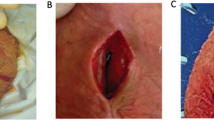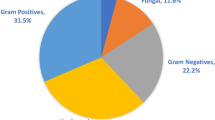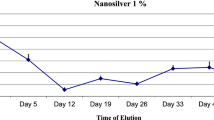Abstract
The aim of this study was to investigate the role of haematogenous seeding in late prosthesis infection. In all, 45 male Wistar albino rats were divided into three equal groups. A small piece of silicone prosthesis was implanted into the scrotum of all rats under sterile condition and antibiotic prophylaxis. In the first group, all silicones were removed after 6 months without any complication and were cultured for bacterial growth. In the second group, a disc, which was saturated with Staphylococcus epidermidis, was inoculated subcutaneously in the legs of the rats in the 6th month, revealing a nodule formation 4–5 days after the inoculation and treated with an appropriate antibiotic after the nodule formation. In the third group, the same disc was inoculated, but all rats were treated immediately from the inoculation time onwards. The silicones of the second and third group were also removed at the end of the 6th month and were cultured to observe the bacterial growth. There was no evidence of prosthesis infection in any of the three groups. In the first group, three cultures were positive and revealed approximately 10 000 colonies of S. epidermidis in two and Proteus mirabilis in the remaining. Three and four cultures were positive in the second and third group, respectively. Low colonies of four different organisms (Escherichia coli, S. aureus, S. epidermidis, Pseudomonas aeruginosa) were identified in these cultures. There was no statistical significance of positive cultures in the three groups. Based on our results, there does not appear to be a true significance of haematogenous seeding on late prosthesis infection.
This is a preview of subscription content, access via your institution
Access options
Subscribe to this journal
Receive 8 print issues and online access
$259.00 per year
only $32.38 per issue
Buy this article
- Purchase on Springer Link
- Instant access to full article PDF
Prices may be subject to local taxes which are calculated during checkout
Similar content being viewed by others
References
Carson CC . Infections in genitourinary prostheses. Urol Clin N Am 1989; 16: 139–147.
Carson CC, Robertson CN . Late hematogenous infection of penile prostheses. J Urol 1988; 139: 50–52.
Karadenizli A et al. Piperacillin with and without tazobactam against extended-spectrum beta-lactamase-producing Pseudomonas aeruginosa in a rat thigh abscess model. Chemotherapy 2001; 47: 292–296.
Gristina AG, Costerton JW . Bacterial adherence to biomaterials and tissue. The significance of its role in clinical sepsis. J Bone Joint Surg Am 1985; 67: 264–273.
Nickel JC, Heaton J, Morales A, Costerton JW . Bacterial biofilm in persistent penile prosthesis-associated infection. J Urol 1986; 135: 586–588.
Haury BB et al. Inhibition of nonspecific defenses by soil infection potentiating factors. Surg Gynecol Obstet 1977; 144: 19–24.
Hau T et al. Mechanisms of the adjuvant action of hemoglobin in experimental peritonitis. 2. Influence of hemoglobin on human leukocyte chemotaxis in vitro. J Surg Res 1977; 22: 174–180.
Hau T, Simmons RL . Mechanisms of the adjuvant effect of hemoglobin in experimental peritonitis. III. The influence of hemoglobin on phagocytosis and intracellular killing by human granulocytes. Surgery 1980; 87: 588–592.
Kabalin JN, Kessler R . Infectious complications of penile prosthesis surgery. J Urol 1988; 139: 953–955.
Randrup ER . Clinical experience with 180 inflatable penile prostheses. South Med J 1995; 88: 47–51.
Montague DK, Angermeier KW, Lakin MM . Penile prosthesis infections. Int J Impot Res 2001; 13: 326–328.
Montague DK . Periprosthetic infections. J Urol 1987; 138: 68–69.
Wilson SK, Delk II JR . Inflatable penile implant infection: predisposing factors and treatment suggestions. J Urol 1995; 153(Part 1): 659–661.
Licht MR, Montague DK, Angermeier KW, Lakin MM . Cultures from genitourinary prostheses at reoperation: questioning the role of Staphylococcus epidermidis in periprosthetic infection. J Urol 1995; 154(Part 1): 387–390.
Fishman IJ, Culha M, Scott FB . Correlation between random intraoperative penile prosthesis culture and clinical infection. J Urol 1998; 159: 221.
Acar O et al. The role of intraoperative antibiotic irrigation and postoperative antibiotic therapy for contaminated implantable prosthesis: in a rat model in vivo. Int J Impot Res 2000; 12: 285–288.
Baker KA . Antibiotic prophylaxis for selected implants and devices. J Calcif Dent Assoc 2000; 28: 620–626.
Author information
Authors and Affiliations
Corresponding author
Rights and permissions
About this article
Cite this article
Çulha, M., Acar, O., Mutlu, B. et al. Prosthesis culture 6 months after implantation and the effect of haematogenous seeding in a rat model. Int J Impot Res 16, 231–234 (2004). https://doi.org/10.1038/sj.ijir.3901142
Received:
Revised:
Accepted:
Published:
Issue Date:
DOI: https://doi.org/10.1038/sj.ijir.3901142



